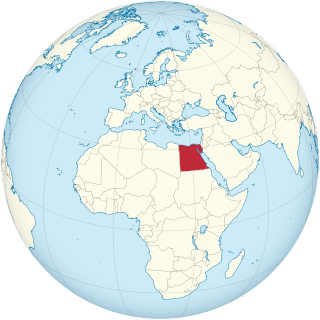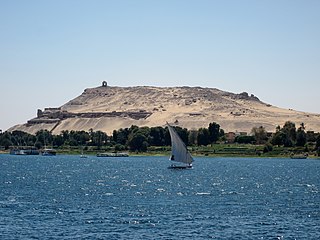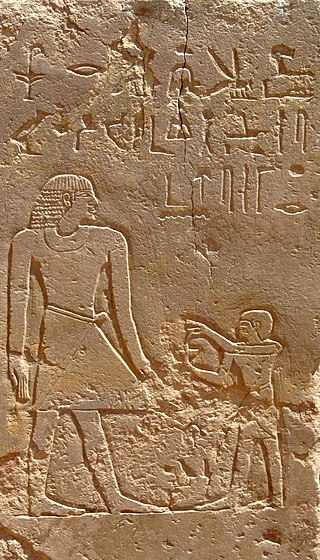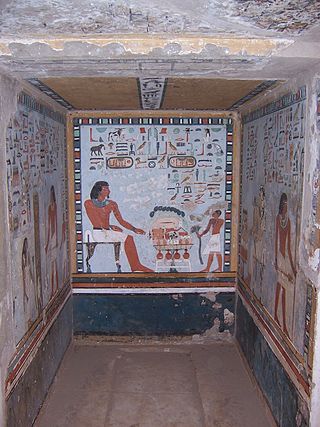
Articles related to Egypt include:

Mentuhotep II, also known under his prenomen Nebhepetre, was an ancient Egyptian pharaoh, the sixth ruler of the Eleventh Dynasty. He is credited with reuniting Egypt, thus ending the turbulent First Intermediate Period and becoming the first pharaoh of the Middle Kingdom. He reigned for 51 years, according to the Turin King List. Mentuhotep II succeeded his father Intef III on the throne and was in turn succeeded by his son Mentuhotep III.

Mentuhotep I may have been a Theban nomarch and independent ruler of Upper Egypt during the early First Intermediate Period. Alternatively, Mentuhotep I may be a fictional figure created during the later Eleventh Dynasty, which rose to prominence under Intef II and Mentuhotep II, playing the role of a founding father.

Sehertawy Intef I was a local nomarch at Thebes during the early First Intermediate Period and the first member of the 11th Dynasty to lay claim to a Horus name. Intef reigned from 4 to 16 years c. 2120 BC or c. 2070 BC during which time he probably waged war with his northern neighbor, the Coptite nomarch Tjauti. Intef was buried in a saff tomb at El-Tarif, known today as Saff el-Dawaba.

Wahankh Intef II was the third ruler of the Eleventh Dynasty of Egypt during the First Intermediate Period. He reigned for almost fifty years from 2112 BC to 2063 BC. His capital was located at Thebes. In his time, Egypt was split between several local dynasties. He was buried in a saff tomb at El-Tarif.
Intef III was the third pharaoh of the Eleventh Dynasty of Egypt during the late First Intermediate Period in the 21st century BC, at a time when Egypt was divided in two kingdoms. The son of his predecessor Intef II and father of his successor Mentuhotep II, Intef III reigned for 8 years over Upper Egypt and extended his domain North against the 10th Dynasty state, perhaps as far north as the 17th nome. He undertook some building activity on Elephantine. Intef III is buried in a large saff tomb at El-Tarif known as Saff el-Barqa.

Qubbet el-Hawa or "Dome of the Wind" is a site on the western bank of the Nile, opposite Aswan, that serves as the resting place of ancient nobles and priests from the Old and Middle Kingdoms of ancient Egypt. The necropolis in use from the Fourth Dynasty of Egypt until the Roman Period.

The Autobiography of Harkhuf is a private tomb inscription from ancient Egypt. It is significant in Egyptology as one of the two most important, and the most famous, autobiographical inscriptions of Old Kingdom officials.

Labib Habachi was a Coptic Egyptian egyptologist.
This page list topics related to ancient Egypt.

Usersatet was an Ancient Egyptian official with the titles king's son of Kush and overseer of the southern countries. He was in office under king Amenhotep II and perhaps in the early years of the reign of Thutmosis IV. As king's son of Kush he was the main official in charge of the Nubian provinces.
Detlef Franke was a German Egyptologist specialist of the Middle Kingdom of Egypt.
Heqaib (III) was an Ancient Egyptian local governor at Elephantine. He lived at the end of the 12th Dynasty around 1800 BC. He held the titles governor and overseer of priests of Khnum, lord of the cataracts.

Ibiaw or Ibiau was an ancient Egyptian vizier and Chief of the town during the 13th Dynasty, likely under pharaohs Wahibre Ibiaw and/or Merneferre Ay.

Sabni was an ancient Egyptian official of the Old Kingdom under king Pepy II. He was an expedition leader undertaking enterprises to Nubia. He is mainly known from his rock cut at Qubbet el-Hawa.

The Bust of Amenemhat V is a sculpture showing the head of the ancient Egyptian king Amenemhat V, who ruled at the beginning of the Thirteenth Dynasty. One of the major art works of this period, it is today in the Kunsthistorisches Museum in Vienna with the inventory number ÄS 37.

Sarenput I was an ancient Egyptian official during the reign of pharaoh Senusret I of the 12th Dynasty.

Sarenput II, also called Nubkaurenakht was an ancient Egyptian nomarch during the reign of pharaohs Senusret II and Senusret III of the 12th Dynasty.
The Temple of Satet or Satis was an ancient Egyptian temple dedicated to the goddess Satet, a personification of the Nile inundation. The temple was located on the Nile Valley island of Elephantine, Egypt. Founded during the late Predynastic Period around 3200 BC, it was enlarged and renovated several times from the Early Dynastic Period onwards over the next 3000 years until the Ptolemaic Period. The temple of Satet is the best example of an ancient Egyptian temple whose construction is attested over the entire pharaonic period.

Martin Bommas is a German Egyptologist, archaeologist, and philologist. He is a professor and Museum Director at the Macquarie University History Museum in Sydney, Australia and the Director of the Qubbet el-Hawa Research Project (QHRP) in Aswan, Egypt. He has published widely on ancient Egyptian mortuary liturgies, rituals and religious texts spanning the Old Kingdom to the Christian era. In archaeology, he has examined the Old and Middle Kingdom settlement remains and the 18th Dynasty temple of Khnum at Elephantine as well as the Old and Middle Kingdom Lower Necropolis at Qubbet el-Hawa. As a museum director, his focus is on historical anthropology, decolonisation and the repatriation of illicitly trafficked artefacts.
















